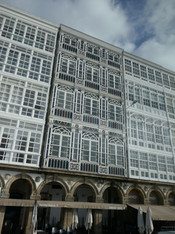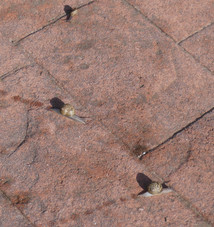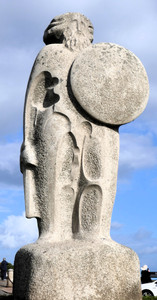A Coruna and Betanzos
- hollymathwriter
- Jun 10, 2023
- 2 min read
April 12, 2023

The Tower of Hercules was built in the 1st century A.D. by the Romans and is still in use today. It was the first place we stopped in A Coruna before journeying on to Betanzos. The artist Pablo, Picasso spent 4 years of his childhood (around 9 to 13 years old) in A Coruna. He and his dad called the Tower of Hercules, the "Tower of Candy" (“Torre de Caramelo"). Its color reminded him of caramel. The budding artist painted the tower during his stay in A Coruna.
Our day began with a pleasant view of A Coruna from our room.

After our tour began, we rode through the streets of A Coruna on our way to the Tower of Hercules.
We only had 20 minutes to walk up to the Tower of Hercules and back. It was a pleasant walk with snails leaving a trail of slime along the path, beautiful birds in the thorny bushes and many cats enjoying the morning sun. Once at the tower, we were also able to see a wonderful stone statue of Hercules, as well as beautiful views of the ocean below.
We then headed out of A Coruna and through the countryside to Betanzos.
Before beginning our walk through Betanzos, we had some time to explore the square and enjoy a morning snack of coffee and churros. The churros pastry had the distinctive shape, but were missing the cinnamon and sugar.

Betanzos is a stop along the El Camino de Santiago, an ancient pilgrimage walk made more modern with the use of cell phones to help pilgrims find their way and locate the iconic stops along their walk where they can get stamps to record their progress. Their way is marked by the scallop shell icon and yellow arrows pointing the way. The scallop shell is the symbol of the El Camino. The ridges of the shell represent the many roads all leading to the same destination - Santiago. In the past, pilgrims carried scallop shells with them on their
which served as a bowl for their food along the way.
We walked down the narrow streets of Betanzos, walking by a statue of the Roman goddess Diana (Artemis in Greece), ancient lampposts, and cafes.
We stopped at the Santiago Church to admire its exterior. It was built in the Gothic style between the 14th and 15th centuries and renovated in the 19th century. We were not able to go inside the church.
The second church we visited was the Church of St. Mary of Azogue built in the late 14th and early 15th century. We were able to look around inside, but the priest was busy supervising the moving of a crucifix and altar.
Right next door was our primary destination, the Church of San Francisco built in the 13th and 14th centuries and dedicated to St. Francis.
We walked back to the bus.

Once on the bus, we left Betanzos and began our return journey.
On the way, we stopped at a local restaurant for tapas (Spanish small dishes or appetizers). They were delicious.
































































































Interesting about the scallop shell being the symbol for El Camino. The tapas look good - it looks like you tried Spanish tortilla (potato and egg omelet). Yum!